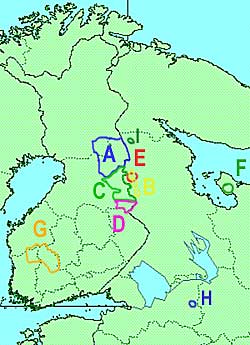Wood decaying polypores in boreal forests of Finland and northwestern Russia - Mariko Lindgren
Study areas and data-sets
A. Koillismaa, Finland 1995
2. All forest-land (n=5) 3. Old-growth forest inventory areas (n=5) B. Intact forest areas in northwestern Russian Karelia, 1995-1996
C. Northeastern Kainuu, Finland 1996D. State lands of southern Kuhmo, Finland 1998
8. Mature, managed pine-dominated forests (n=11) E. Planned Kalevala National Park, Russian Karelia 1998-1999
F. Onega peninsula, Archangelsk region, Russia 1999
G. State lands of northern Häme, Finland 1999-2000
12. Mature, managed pine-dominated forests (n=21) H. Veps forest, Leningrad region, Russia 2000
I. Pijaozero, Russian Karelia 2001
In all data-sets, quantitative data about dead trees and occurrence of wood decaying polypores was collected from randomly selected 0.5 hectare study plots. Above, total number of study plots (n) in each data-set is given in paranthesis after the name of the data-set. All field-methods are described on separate sub-pages. Altogether the data-sets include 172 independent study plots and over 25 381 dead trees, of which 14 587 were over 10 cm in their breast height diametre. Data from two managed study plots in northern Häme is still missing from these figures. |
